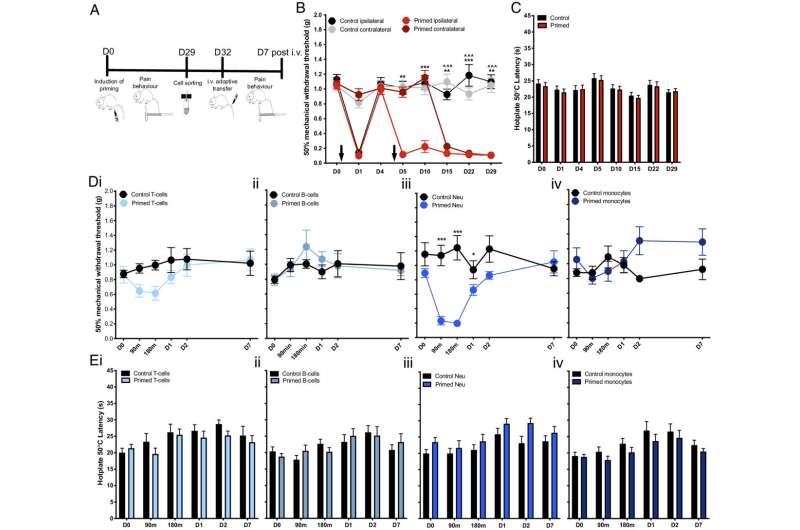May 1, 2023 report
This article has been reviewed according to Science X's editorial process and policies. Editors have highlighted the following attributes while ensuring the content's credibility:
fact-checked
peer-reviewed publication
trusted source
proofread
Possible association found between neutrophil migration into sensory ganglia and fibromyalgia pain

A team of biomedical researchers from Queen Mary University of London, Hebrew University and University College London has found evidence of an association between fibromyalgia-type symptoms and migration of neutrophils into sensory ganglia. In their study, reported in Proceedings of the National Academy of Sciences, the group explored possible causes of fibromyalgia in mouse experiments.
Fibromyalgia leads to fatigue, depression, sleep problems and widespread pain throughout the body. In the past, patients with fibromyalgia usually did not have other measurable symptoms, so doctors for many years doubted its existence. In recent years, some physical signs have been found, including elevated levels of neutrophils in the bloodstream and associated cytokines that are produced by the neutrophils.
Some research has also shown that the means by which the neutrophils cause pain by is invading bundles of ganglia in the central nervous system.
Neutrophils are the most abundant type of white blood cell produced by the human body. They play an essential role in fighting off infections as part of the innate immune system. Medical researchers still do not know why elevated levels occur in people with fibromyalgia, but suggest it hints at a possible problem with the immune system overreacting to some as yet unknown element.
Recent research has also found evidence that fibromyalgia may be the result of the central nervous system amplifying nerve signals as they pass through the brain and spinal cord—also for some unknown reason. In this new effort, the researchers tested the idea that the overabundance of neutrophils leads directly to pain in patients.
Testing involved collecting neutrophils from fibromyalgia patients with abnormally high levels of the cells and injecting them into test mice. After a brief period, they tested the mice to see if they became more sensitive to pain than usual and found that they did. Dissection showed that the neutrophils had made their way to the central nervous system and had invaded sensory ganglia—likely the source of the increase in pain sensitivity observed in the mice.
The researchers say their findings establish a link between neutrophils and the pain associated with fibromyalgia, which suggests therapies to reduce such levels may provide relief for such people.
More information: Sara Caxaria et al, Neutrophils infiltrate sensory ganglia and mediate chronic widespread pain in fibromyalgia, Proceedings of the National Academy of Sciences (2023). DOI: 10.1073/pnas.2211631120
© 2023 Science X Network

















